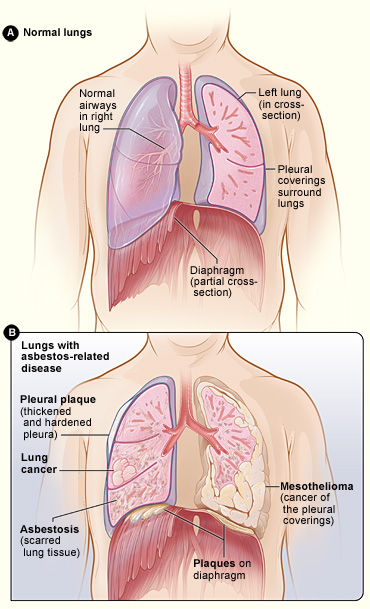Pleural Thickening

The pleura is a two-layered membrane which surrounds the lungs and lines the inside of the rib cage. Some of the inhaled asbestos fibres may find their way into the pleura which may cause a scarring causing the pleura to thicken that may show up on a chest x- ray. Diffuse pleural thickening extends over a large area and may restrict expansion of the lungs causing breathlessness. while pleural plaques are localised areas of thickening which usually do not interfere with breathing.
One of the four conditions that can develop from asbestos exposure is pleural plaque and thickening. The others are asbestosis, lung cancer, and mesothelioma (a cancer of the lining that surrounds the lungs, heart or abdominal cavity).
Pleural plaques are the most common condition associated with asbestos exposure; more than 80% of patients with pleural plaques have had a history of asbestos exposure. Pleural plaques develop 20 to 40 years after exposure to asbestos and may occur after low, intermittent exposure. After 20 years, uncalcified pleural plaques can be found in five to 15% of people who were exposed to asbestos at their workplace. Thirty years after the first exposure to asbestos, about a third to one half of people have calcified pleural plaques. A person with pleural plaques may show no other signs of asbestos exposure; however, pleural plaques are present in almost all patients with asbestosis, so the discovery of pleural plaques is a cause for concern.
Pleural plaques are smooth, white, raised irregular areas of tissue formed from collagen bundles arranged in a basket-weave pattern. They almost always appear on the parietal pleura (the outer lining that surrounds the lung). The plaques may contain asbestos fibers and often become calcified as time goes by. They range from small to large, and if calcified can be more easily seen on a chest x-ray.
The larger the plaque, the greater the chance that more asbestos fibers will be found in the patient's lungs, especially if the plaque is calcified. However, the absence of pleural plaques is not a guarantee that asbestos hasn't invaded the lungs; some people with no pleural plaques still have a high concentration of asbestos fibers in the lungs and pleura.
Information source www.asbestos.net

